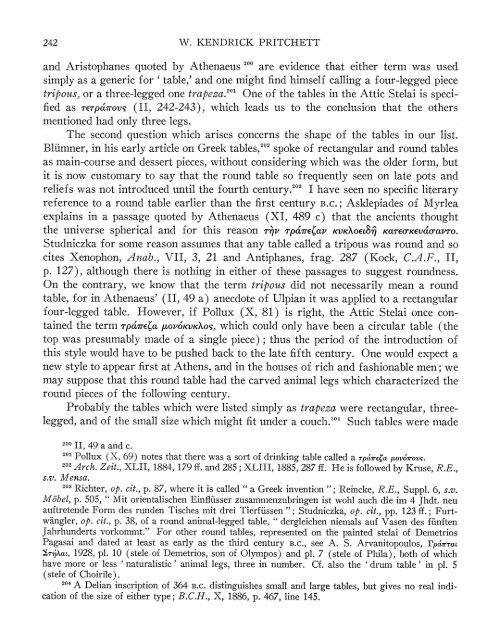the attic stelai - The American School of Classical Studies at Athens
the attic stelai - The American School of Classical Studies at Athens
the attic stelai - The American School of Classical Studies at Athens
You also want an ePaper? Increase the reach of your titles
YUMPU automatically turns print PDFs into web optimized ePapers that Google loves.
242 W. KENDRICK PRITCHETT<br />
and Aristophanes quoted by A<strong>the</strong>naeus 200 are evidence th<strong>at</strong> ei<strong>the</strong>r term was used<br />
simply as a generic for 'table,' and one might find himself calling a four-legged piece<br />
tripous, or a three-legged one trapeza.201 One <strong>of</strong> <strong>the</strong> tables in <strong>the</strong> Attic Stelai is specified<br />
as TETpaiTrovS (II, 242-243), which leads us to <strong>the</strong> conclusion th<strong>at</strong> <strong>the</strong> o<strong>the</strong>rs<br />
mentioned had only three legs.<br />
<strong>The</strong> second question which arises concerns <strong>the</strong> shape <strong>of</strong> <strong>the</strong> tables in our list.<br />
Bliumner, in his early article on Greek tables,202 spoke <strong>of</strong> rectangular and round tables<br />
as main-course and dessert pieces, without considering which was <strong>the</strong> older form, but<br />
it is now customary to say th<strong>at</strong> <strong>the</strong> round table so frequently seen on l<strong>at</strong>e pots and<br />
reliefs was not introduced until <strong>the</strong> fourth century.203 I have seen no specific literary<br />
reference to a round table earlier than <strong>the</strong> first century B.C.; Asklepiades <strong>of</strong> Myrlea<br />
explains in a passage quoted by A<strong>the</strong>naeus (XI, 489 c) th<strong>at</strong> <strong>the</strong> ancients thought<br />
<strong>the</strong> universe spherical and for this reason T'v TpaLTE;c KVKXOEL& KaTEOKEvao-aVrO.<br />
Studniczka for some reason assumes th<strong>at</strong> any table called a tripous was round and so<br />
cites Xenophon, Anab., VII, 3, 21 and Antiphanes, frag. 287 (Kock, C.A.F., II,<br />
p. 127), although <strong>the</strong>re is nothing in ei<strong>the</strong>r <strong>of</strong> <strong>the</strong>se passages to suggest roundness.<br />
On <strong>the</strong> contrary, we know th<strong>at</strong> <strong>the</strong> term tripous did not necessarily mean a round<br />
table, for in A<strong>the</strong>naeus' (II, 49 a) anecdote <strong>of</strong> Ulpian it was applied to a rectangular<br />
four-legged table. However, if Pollux (X, 81) is right, <strong>the</strong> Attic Stelai once contained<br />
<strong>the</strong> term Tpa'rEZa /LOVoKVKXOS, which could only have been a circular table (<strong>the</strong><br />
top was presumably made <strong>of</strong> a single piece); thus <strong>the</strong> period <strong>of</strong> <strong>the</strong> introduction <strong>of</strong><br />
this style would have to be pushed back to <strong>the</strong> l<strong>at</strong>e fifth century. One would expect a<br />
new style to appear first <strong>at</strong> A<strong>the</strong>ns, and in <strong>the</strong> houses <strong>of</strong> rich and fashionable men; we<br />
may suppose th<strong>at</strong> this round table had <strong>the</strong> carved animal legs which characterized <strong>the</strong><br />
round pieces <strong>of</strong> <strong>the</strong> following century.<br />
Probably <strong>the</strong> tables which were listed simply as trapeza were rectangular, threelegged,<br />
and <strong>of</strong> <strong>the</strong> small size which might fit under a couch."04 Such tables were made<br />
200 II, 49 a and c.<br />
201<br />
Pollux (X, 69) notes th<strong>at</strong> <strong>the</strong>re was a sort <strong>of</strong> drinking table called a TpawrEca 4Lovo7roVs.<br />
202<br />
Arch. Zeit., XLII, 1884, 179 if. and 285; XLIII, 1885, 287 if. He is followed by Kruse, R.E.,<br />
s.v. Mensa.<br />
203<br />
Richter, op. cit., p. 87, where it is called " a Greek invention "; Reincke, R.E., Suppl. 6, s.v.<br />
Mabel, p. 505, " Mit orientalischen Einfluisser zusammenzubringen ist wohl auch die im 4 Jhdt. neu<br />
auftretende Form des runden Tisches mit drei Tierfiissen "; Studniczka, op. cit., pp. 123 ff.; Furtwangler,<br />
op. cit., p. 38, <strong>of</strong> a round animal-legged table, " dergleichen niemals auf Vasen des fiinften<br />
Jahrhunderts vorkommt." For o<strong>the</strong>r round tables, represented on <strong>the</strong> painted <strong>stelai</strong> <strong>of</strong> Demetrios<br />
Pagasai and d<strong>at</strong>ed <strong>at</strong> least as early as <strong>the</strong> third century B.C., see A. S. Arvanitopoulos, rpapraL<br />
YrTu<strong>at</strong>, 1928, pl. 10 (stele <strong>of</strong> Demetrios, son <strong>of</strong> Olympos) and pl. 7 (stele <strong>of</strong> Phila), both <strong>of</strong> which<br />
have more or less 'n<strong>at</strong>uralistic' animal legs, three in number. Cf. also <strong>the</strong> 'drum table' in pl. 5<br />
(stele <strong>of</strong> Choirile).<br />
204 A Delian inscription <strong>of</strong> 364 B.C. distinguishes small and large tables, but gives no real indic<strong>at</strong>ion<br />
<strong>of</strong> <strong>the</strong> size <strong>of</strong> ei<strong>the</strong>r type; B.C.H., X, 1886, p. 467, line 145.
















